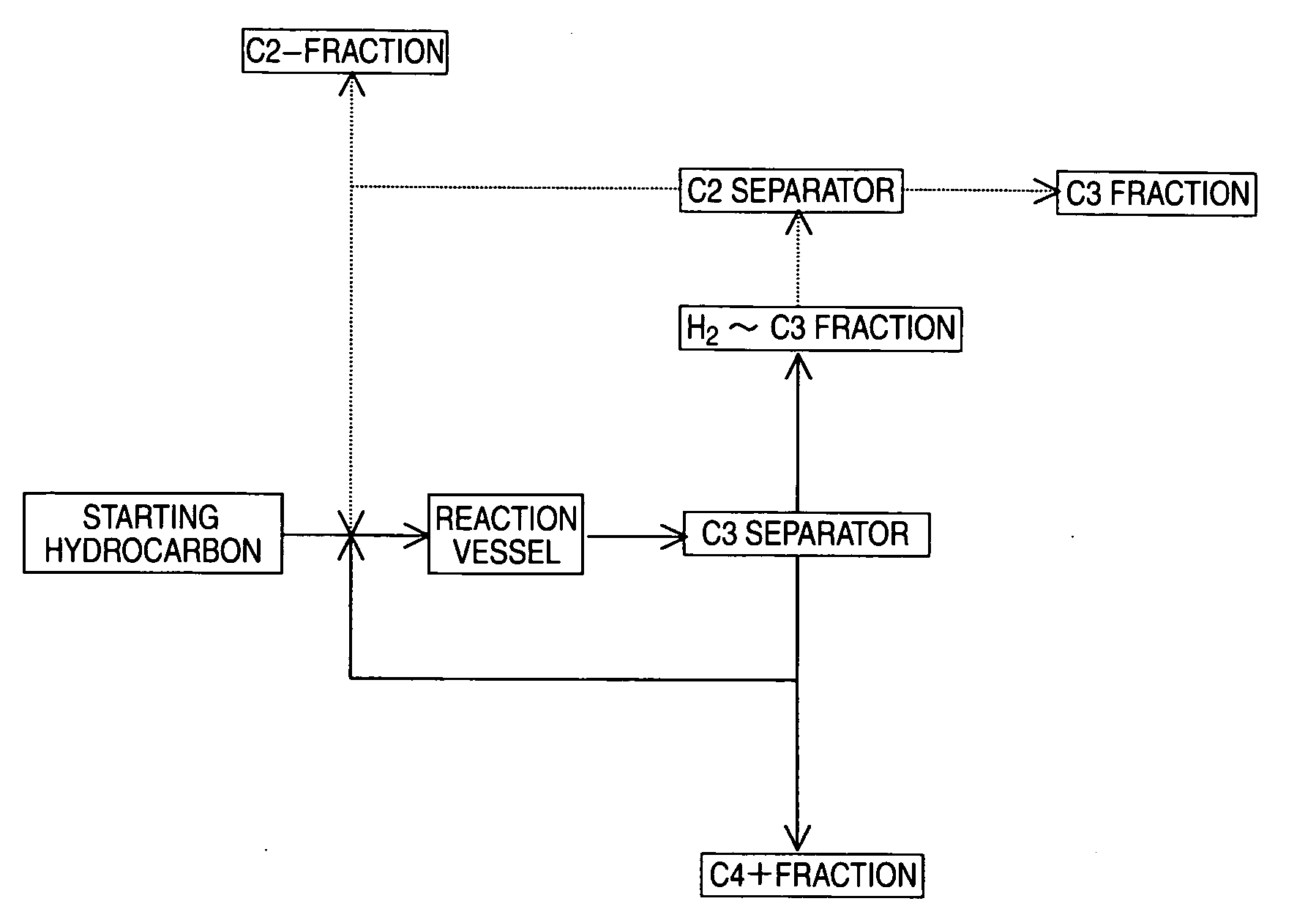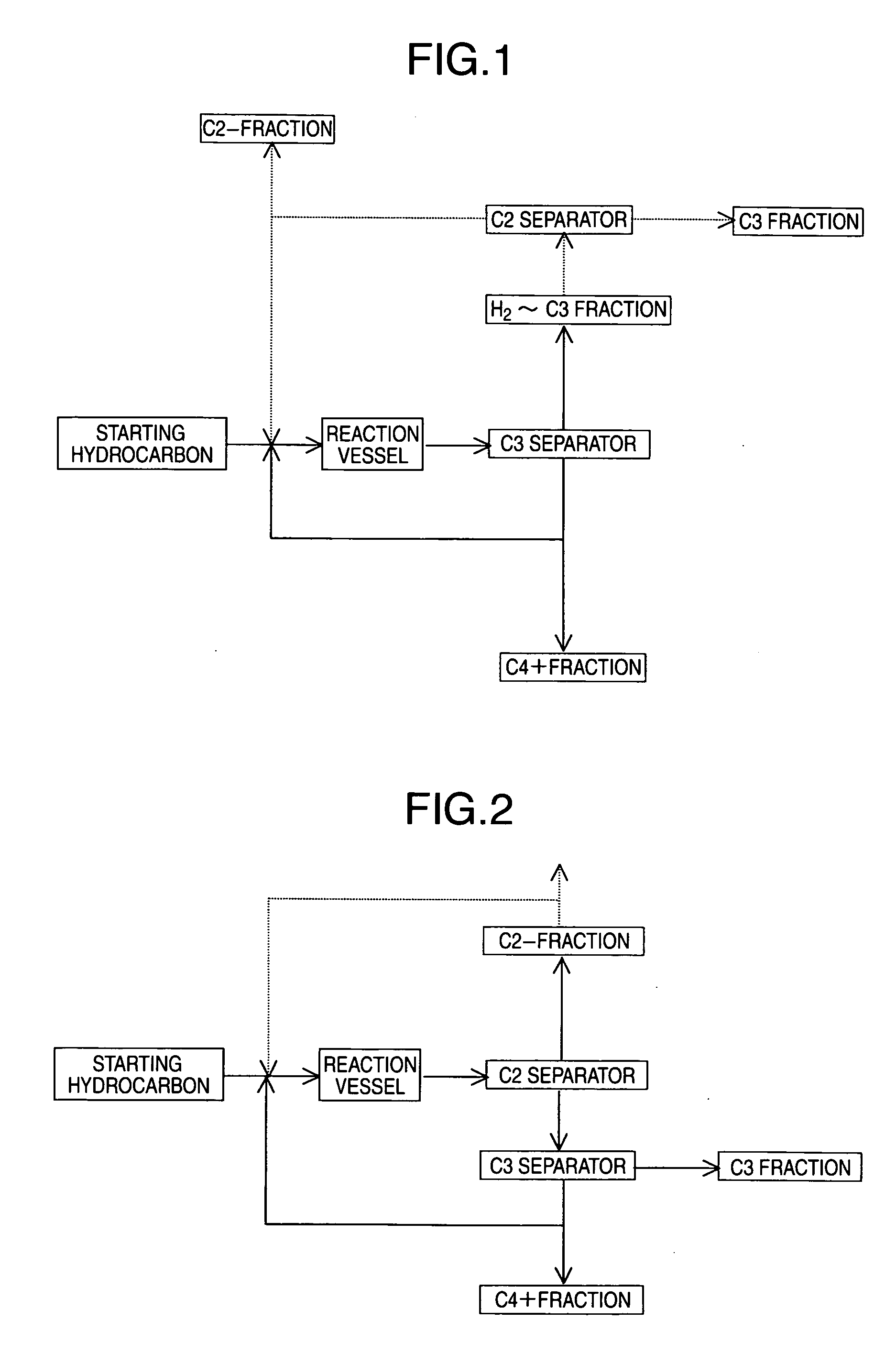Process for Producing Ethylene and Propylene
- Summary
- Abstract
- Description
- Claims
- Application Information
AI Technical Summary
Benefits of technology
Problems solved by technology
Method used
Image
Examples
example 1
[0144] An extrusion molded article of H type ZSM-5 having a molar ratio SiO2 / Al2O3 of 1000 (containing 30% by mass of SiO2 binder and having 1.6 mmφ, and bought from Nikki Universal Co., Ltd.) was dispersed in a 1N aqueous sodium nitrate solution (10 cc / g-zeolite molded body), and ion exchanging treatment was carried out at room temperature for 1 hour repeatedly three times, followed by carrying out filtration, washing with water and drying to prepare an Na type ZSM-5 / SiO2. This was dispersed in a 0.01N aqueous silver nitrate solution (10 cc / g-zeolite molded body), and ion exchanging was carried out at room temperature for 2 hours, followed by filtration, washing with water and drying to prepare a catalyst A. The amount of Ag in the catalyst A measured by fluorescent X-ray analysis was 0.15% by mass. The catalyst A was packed in a quartz glass reaction vessel of 16 mmφ in inner diameter and subjected to steaming for 5 hours under the conditions of a temperature of 650° C., a steam f...
example 2
[0160] An experiment corresponding to recycling of ethylene was conducted under the same conditions as in Example 1, except that the C4 raffinate-2 in an amount of 26.8 g / hr, the C4+ fraction in an amount of 27.2 g / hr, and ethylene in an amount of 6 g / hr (WHSV=6 hr−1) were used as the starting materials fed to the reaction vessel.
[0161] The results of analysis of the reaction product after 4 hours from starting of the reaction were that yields of propylene and ethylene (% by mass) with respect to the olefin of 4-8 carbon atoms in the feed starting material were 34.8% and 0.5%, respectively. A comparison with Example 1 shows that production of ethylene was suppressed by recycling ethylene and that the yield of propylene was improved.
example 3
[0162] An extrusion molded article of Na type ZSM-5 having a molar ratio SiO2 / Al2O3 of 1200 (containing 30% by mass of SiO2 binder and having 1.6 mmφ, and bought from Nikki Universal Co., Ltd.) was dispersed in 0.02N aqueous silver nitrate solution (10 cc / g-zeolite molded body), and ion exchange treatment was carried out at 60° C for 1 hour which was repeated two times, followed by carrying out filtration, washing with water and drying to prepare a catalyst B. The amount of Ag in the catalyst B measured by fluorescent X-ray analysis was 0.22% by mass. The catalyst B was packed in a reaction vessel made of HASTELLOY C having an inner diameter of 27 mmφ and subjected to steaming for 5 hours under the conditions of a temperature of 650° C., a steam flow rate of 214 g / hr, a nitrogen flow rate of 400 NL / hr, and a pressure of 0.1 MPaG. The amount of protons in the catalyst B, after the steaming treatment, was measured by liquid phase ion exchanging / filtrate titration method and determined...
PUM
| Property | Measurement | Unit |
|---|---|---|
| Temperature | aaaaa | aaaaa |
| Temperature | aaaaa | aaaaa |
| Temperature | aaaaa | aaaaa |
Abstract
Description
Claims
Application Information
 Login to View More
Login to View More - R&D
- Intellectual Property
- Life Sciences
- Materials
- Tech Scout
- Unparalleled Data Quality
- Higher Quality Content
- 60% Fewer Hallucinations
Browse by: Latest US Patents, China's latest patents, Technical Efficacy Thesaurus, Application Domain, Technology Topic, Popular Technical Reports.
© 2025 PatSnap. All rights reserved.Legal|Privacy policy|Modern Slavery Act Transparency Statement|Sitemap|About US| Contact US: help@patsnap.com


